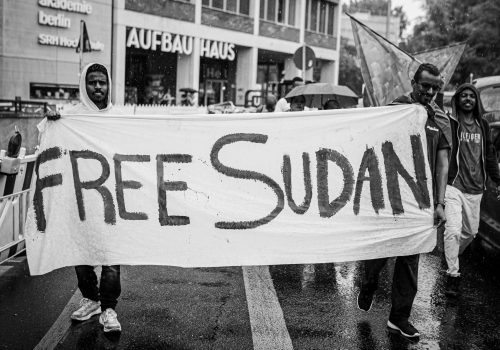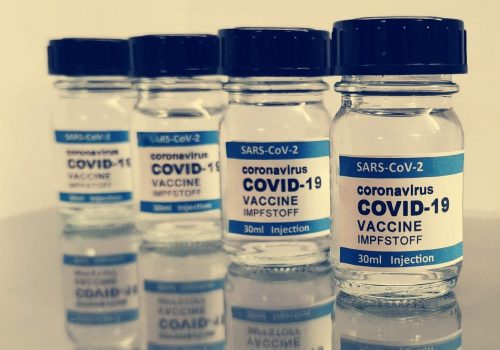The unintended consequence of Ethiopia’s civil war might be a border war with Sudan
Ethiopia is at war with itself—and the international community is struggling to respond. In nearly four months of fighting across Ethiopia’s Tigray region, more than sixty thousand Tigrayan refugees have fled into neighboring Sudan and 80 percent of the region’s six million citizens have been cut off from life-saving humanitarian access. Despite rolling media and internet blackouts, a steady trickle of stories has emerged that paint a gruesome picture of mass atrocities, widespread rape, summary executions, and the wholesale destruction of the region’s critical infrastructure.
In recent weeks, the United States and its European allies have launched a diplomatic campaign to convince Ethiopia’s once-venerated prime minister, Abiy Ahmed, to relent in his campaign to vanquish militarily his greatest political threat in the Tigray People’s Liberation Front (TPLF). I once feared the onset of a bloody struggle for control over Tigray that would pit near-equally matched foes against each other in something approximating conventional, interstate war. But what has instead emerged is a widespread TPLF insurgency that could drag on and take as many lives through deprivation as it does through combat.
The stakes in Tigray are high and the civilian toll could be considerable. But there’s another scenario, with the potential to exact an even higher toll, that many observers are overlooking: conventional war that could break out at any moment between Sudan and Ethiopia and their many allied proxies. Indeed, it is this possible unintended consequence of Abiy’s “law and order operation” in Tigray that could well do the most extensive damage in the region. In contrast to the conflict in Tigray, however, it is not too late for the United States and its allies in the region and beyond to do something to prevent a border war that would amount to a historic strategic blunder.
The seeds of this potential calamity were planted at the start of the last century when the border between Ethiopia and Sudan was first agreed to, though never formally demarcated, by modern Ethiopia’s founding father, Emperor Menelik II, during the British-Sudanese condominium. Since 1993, a patch of agricultural land on the Sudanese side of the border, referred to as the al-Fashqa Triangle, has been occupied by Amhara farmers. Many of them were relocated there by the Sudanese government in recognition of historic claims to the area by this powerful minority group. Since 2008, a de-facto agreement has existed whereby Ethiopia has acknowledged the historic legal boundary putting al-Fashqa inside Sudan, while Sudan has granted Amhara farmers continued rights to cultivate the land. Efforts to definitively demarcate the border have been stalled since the last meeting of an ad-hoc border commission last year, but Sudan’s designs on the region have never abated. Indeed, as recently as August 2020, in remarks by the head of the Sudanese army and chairman of the transitional government’s Sovereign Council, Lieutenant General Abdel Fattah al-Burhan, to the Army General Command, he predicted that they would “raise the flag of Sudan above al-Fashqa… and not waste one inch of the homeland.”
What has broken that decade-plus status quo is the onset of conflict in Tigray and a series of strategic and tactical calculations by the Sudanese Armed Forces (SAF). Unlike many outsiders, senior-level Sudanese officials claim not to have been surprised by the brutal assault by the TPLF on the Ethiopian National Defense Force (ENDF) Northern Command outpost in Mekelle, the Tigrayan regional capital, on the night of November 4. Only a week prior, a delegation led by the deputy head of Sudan’s Sovereign Council and head of the Rapid Support Forces (RSF) militia, General Mohammed “Hemedti” Dagalo, met with Abiy in Addis, where the restive Tigray region, mounting border tensions, and the stalemated negotiations over the Grand Ethiopian Renaissance Dam (GERD) were all reportedly topics of discussion.
More surprising to the Sudanese was the Ethiopian government’s near-immediate need for supplementary troops—pulled in from Ethiopian deployments in Somalia and, most notably, the al-Fashqa Triangle—to respond to the TPLF attack in Mekelle. The subsequent entry into the Tigray conflict of Eritrean forces and Amhara state militias further indicated that the ENDF was unable to subdue the TPLF uprising on its own and was operating from a greater position of relative weakness than was perhaps anticipated.
By December, as primarily SAF forces gathered along the Sudanese side of the border to monitor the crossing of Tigrayan refugees and possible retreating TPLF forces, SAF and ENDF troops found themselves in closer proximity than ever before—increasing the risk of clashes. Multiple ENDF surprise assaults on SAF army officers prompted SAF forces to move in on the night of December 29. In that incursion, SAF forces reportedly destroyed Ethiopian army outposts and administrative centers while also displacing Amhara farmers and destroying crops in their successful bid to reclaim the entirety of the al-Fashqa Triangle.
Sudan has presented its tactical decision as a legitimate response in light of the ENDF’s own unprovoked incursions against Sudanese patrols and Khartoum’s historic and legal claims to the area. But there is no question that the SAF, which has witnessed its traditional importance in Sudan’s body politic decline substantially under the country’s civilian-led transitional government, see in their defense of Sudan’s territorial integrity an opportunity to once again assert its primacy as the protector of the Sudanese state.
It is also true that in its effort to change facts on the ground, whether justified or not, the SAF has now further aggravated an inherently unstable situation in the region and may have disrupted the delicate balance among security forces inside Sudan that has kept the transition there on track.
As bellicose rhetoric by both sides has increased in recent weeks, Khartoum and Addis have come to frame the threat of territorial loss in national-security and even existential terms—similar in certain respects to how each side has recently described the contentious and protracted GERD talks. Sudan’s ambassador to Ethiopia was recently recalled to Khartoum, and various peace envoys and proposed mediators from the United Arab Emirates, Turkey, South Sudan, and the African Union (AU) have all largely seen their willingness to help the parties achieve a negotiated solution rebuffed. Even Eritrea, whose peace agreement with Ethiopia has emerged as more of a mutual-security pact, tried unconvincingly to paint itself as a peacemaker in a letter last week from President Isaias Afwerki to Sudanese Prime Minister Abdalla Hamdok. Sudan’s newly appointed foreign minister, Mariam al Saddig, suggested in late February that Sudan would be open to talks under the auspices of the Intergovernmental Authority on Development (IGAD). But that regional body, currently chaired by Hamdok and historically controlled by Ethiopia, has not yet offered its good offices and likely lacks the independence to offer impartial mediation.
In the absence of concerted external mediation, both sides risk turning their cold war much hotter. And with such intertwined politics and long histories, both sides have the points of leverage to do it. Ethiopia currently supplies the totality of troops (more than five thousand) to the United Nations (UN) peacekeeping mission in Abyei, the highly contested region along the Sudan-South Sudan border that remains at the heart of the tensions between those two countries. Concerns abound that Ethiopia could withdraw those troops, potentially forcing the SAF to fill a security vacuum there that could well spark renewed conflict with Juba. There are also worries that Sudan could unilaterally expel those forces out of fear that Ethiopia could use these forces as a fifth column in the event of a sustained outbreak of violence along its border—opening a new front against Sudan and vastly expanding their zone of conflict. Addis, for its part, is right to fear Khartoum’s ability to re-arm and re-supply TPLF rebels should Sudan wish to open its own additional front in a border conflict.
Adding to the volatility has been an influx of allied armies and militias into the border zone between Sudan and Ethiopia. On the Ethiopian side, it is not just the ENDF, but also Amhara militias and Eritrean Defense Forces. Similarly, on the Sudanese side of the border, the SAF, the RSF, and local militias have also been identified in increasingly large numbers.
Given the lack of interoperability among many of these forces, coupled with the fact that the vast majority of this mobilization is occurring in a narrow band along the border that is only a few kilometers wide, the chances are high that the slightest misstep or miscalculation could result in a large-scale outbreak of violence and a rapid escalation among three national armies and many state and national militias. This is particularly true inside Sudan, where the SAF, the RSF, and local militias have even turned on each other in the past year in areas like Darfur and Kordofan when they have been deployed in close proximity.
Absent some kind of international monitoring, there are simply too many well-armed forces in too close proximity with too little experience working with each other to discount the risk of a cataclysmic conflict breaking out.
The tense standoff has bred rumors that additional outside forces could light the spark that ignites that conflict. Egypt, which has grown increasingly frustrated with the state of GERD negotiations, is often identified as a prime potential instigator. But while there is no question that Egypt has sought to use its historic ties to Sudan to produce a GERD outcome to its liking, Egyptian officials privately express a clear-eyed understanding that an Ethiopia wracked by internal war and interstate conflict will be incapable of focusing on, let alone reaching, a binding political and technical agreement on the demanding issues that the GERD presents.
So where do we go from here? It seems unlikely that ad-hoc bilateral demands for de-escalation and withdrawal from contested areas will be sufficient at this stage. Late last month, AU Commission Chairman Moussa Faki Mahamat dispatched retired Mauritanian diplomat Mohamed Lebatt to Addis and Khartoum to probe each side’s willingness to accept outside meditation on the brewing border conflict. While no progress was made, it is a conversation worth building on.
Coordinated, high-level outside mediation is urgently required to avert the potentially dire consequences of a conflict for not just the civilian populations in the border area, but also the countries at the center of the dispute and the Horn of Africa as a whole. Sudan recently proposed outside mediation for the final phase of the GERD negotiations that would include the United States, the European Union, the United Nations, and the African Union. Some sponsorship of border mediation by this grouping—under the leadership of an eminent, empowered figure—is worth pursuing given the substantial risks to international peace and security and the potential for the parties’ largest donors to bring financial leverage to efforts to reach a resolution.
While all these disputes are linked, there is no single process, individual, or institution that will be able to untangle the overlapping and complicated politics of the competing conflicts. What is essential is coordination. Any process that can be put in place to help with the de-escalation of war in Tigray should be kept on its own track. So too with the GERD. And so too with a process for unwinding the military buildup and tensions on the border, which should be narrowly defined and time-limited so as not to be exploited as a potential leverage point in any other mediation processes. But these must all be coordinated by a central Contact Group with the power, leverage, and legitimacy to advance options for resolution and enforce outcomes that contribute to overall peace.
Such processes must be jumpstarted now to avoid a downward spiral, and there are several immediate steps that Washington can take to do just that. In a fortunate coincidence, the United States took up the presidency of the UN Security Council in March. The newly installed US ambassador to the UN, Linda Thomas-Greenfield, should prioritize a special session of the Security Council to discuss the manifold crises emerging in the Horn of Africa, with added attention to the still-unfolding conflict in Tigray and the stalemated GERD talks. Given the many competing interests at play in the Horn from all manner of external powers, the session should include discussion of an International Contact Group that can promote dialogue and transparency and ensure that potential spoilers remain in the tent rather than outside of it.
To support and complement this effort, the United States should also appoint a Horn of Africa envoy who is capable of both setting the policy agenda in Washington and corralling leaders in Europe and the region in the near term. In the long run, an envoy can only succeed if he or she is equipped with a clear set of policy objectives and the tools to advance them. In contrast to its approach in the Great Lakes or Sahel regions, Washington has for too long viewed the countries in the promising but volatile Horn of Africa in a vacuum or else simply provided wide berth to the area’s anchor state, Ethiopia, to project its power and influence to police regional disputes. With Addis having lost the ability to play that role any longer, the burden has shifted to Washington to become more actively involved in protecting its interests in the region.
That process promises to be complicated and messy. But preventing a war is surely more attractive an enterprise than ending one.
Cameron Hudson is a senior fellow at the Atlantic Council’s Africa Center. Previously he served as the chief of staff to the special envoy for Sudan and as director for African Affairs on the National Security Council in the George W. Bush administration. Follow him on Twitter @_hudsonc.
Further reading
Image: Uprooted from their homes, women and children are hit hard by the conflict in Metekel Zone, Benishangul Gumuz region. (Flickr/UNICEF/Mulugeta Ayene)



